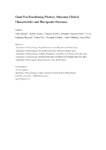Giant non-functioning pituitary adenoma: clinical characteristics and therapeutic outcomes

Ver/
Use este enlace para citar
http://hdl.handle.net/2183/29943Coleccións
- Investigación (FCS) [1295]
Metadatos
Mostrar o rexistro completo do ítemTítulo
Giant non-functioning pituitary adenoma: clinical characteristics and therapeutic outcomesAutor(es)
Data
2020-01-02Cita bibliográfica
Iglesias P, Arcano K, Triviño V, Guerrero-Pérez F, Rodríguez Berrocal V, Vior C, et al. Giant non-functioning pituitary adenoma: clinical characteristics and therapeutic outcomes. Exp Clin Endocrinol Diabetes. 2021;129(4):309-313
Resumo
[Abstract] Background: Giant pituitary adenoma (≥4 cm) is a rare tumor whose clinical features and prognosis are not well known.
Aim: To evaluate the clinical characteristics and therapeutic outcomes of giant non-functioning PA (gNFPA).
Patients and methods: A retrospective multicenter study of gNFPA patients diagnosed in a 12-year period was performed. In each patient, clinical data and therapeutic outcomes were registered.
Results: Forty patients (24 men, age 54.2 ± 16.2 years) were studied. The maximum tumor diameter [median (interquartile range)] was 4.6 cm (4.1-5.1). Women had larger tumors [4.8 cm (4.2-5.4) vs. 4.5 cm (4.0-4.9); p=0.048]. Hypopituitarism [partial (n=22, 55%) or complete (n=9, 22.5%)] at diagnosis was present in 77.5% of the patients. Visual field defects were found in 90.9%. The most used surgical technique was endoscopic endonasal transsphenoidal (EET) surgery (n=31, 77.5%). Radiotherapy was used in 11 (27.5%) patients (median dose 50.4 Gy, range 50-54). Thirty-seven patients were followed for 36 months (10-67 months). Although more than half of these patients showed tumor persistence (n=25, 67.6%), tumor size was significantly reduced [0.8 cm (0-2.5); p<0.001]. At last visit, 12 patients (32.4%) showed absence of tumor on MRI. Hypopituitarism rate was similar (75.0%), although with significant changes (p<0.001) in the distribution of the type of hypopituitarism. The absence of tumor at the last visit was positively associated with positive immunohistochemical staining for FSH (p=0.01) and LH (p=0.006) and negatively with female sex (p=0.011), cavernous sinus invasion (p=0.005) and the presence of Knosp grade 4 (p=0.013).
Conclusion: gNFPAs are more frequent in men but tumors are larger in women. Surgical treatment is followed by a complete tumor resection rate of approximately 30%. Positive immunostaining for gonadotropins is associated with tumor absence at last revision, while female sex and invasion of the cavernous sinuses with tumor persistence.
Palabras chave
Giant non-functioning pituitary adenoma
Hypopituitarism
Visual field defects
Neurosurgery
Therapeutic outcome
Hypopituitarism
Visual field defects
Neurosurgery
Therapeutic outcome
Versión do editor
ISSN
0947-7349





